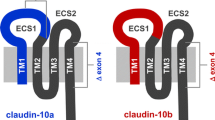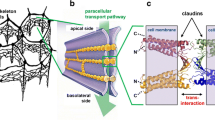Abstract
Barrier properties of tight junctions are determined by the claudin protein family. Many claudins seal this barrier, but others form paracellular channels. Among these, no claudins with general and clear-cut anion selectivity have yet been described, while for claudin-10a and claudin-4, only circumstantial or small anion selectivities have been shown. A claudin with unknown function and tissue distribution is claudin-17. We characterized claudin-17 by overexpression and knock-down in two renal cell lines. Overexpression in MDCK C7 cell layers caused a threefold increase in paracellular anion permeability and switched these cells from cation- to anion-selective. Knockdown in LLC-PK1 cells indorsed the finding of claudin-17-based anion channels. Mutagenesis revealed that claudin-17 anion selectivity critically depends on a positive charge at position 65. Claudin-17 expression was found in two organs: marginal in brain but abundant in kidney, where expression was intense in proximal tubules and gradually decreased towards distal segments. As claudin-17 is predominantly expressed in proximal nephrons, which exhibit substantial, though molecularly not defined, paracellular chloride reabsorption, we suggest that claudin-17 has a unique physiological function in this process. In conclusion, claudin-17 forms channels within tight junctions with distinct anion preference.










Similar content being viewed by others
Abbreviations
- Cldn:
-
Claudin
- DCT:
-
Distal convoluted tubule
- Occl:
-
Occludin
- PCT:
-
Proximal convoluted tubule
- tAL:
-
Thin ascending limb of Henle
- TAL:
-
Thick ascending limb of Henle
- TJ:
-
Tight junction
References
Raleigh DR, Marchiando AM, Zhang Y, Shen L, Sasaki H, Wang Y, Long M, Turner JR (2010) Tight junction-associated MARVEL proteins MarvelD3, tricellulin, and occludin have distinct but overlapping functions. Mol Biol Cell 7:1200–1213
Ikenouchi J, Furuse M, Furuse K, Sasaki H, Tsukita S, Tsukita S (2005) Tricellulin constitutes a novel barrier at tricellular contacts of epithelial cells. J Cell Biol 171:939–945
Steed E, Rodrigues NT, Balda MS, Matter K (2009) Identification of MarvelD3 as a tight junction-associated transmembrane protein of the occludin family. BMC Cell Biol 10:95
Mineta K, Yamamoto Y, Yamazaki Y, Tanaka H, Tada Y, Saito K, Tamura A, Igarashi M, Endo T, Takeuchi K, Tsukita S (2011) Predicted expansion of the claudin multigene family. FEBS Lett 585:606–612
Furuse M, Hata M, Furuse K, Yoshida Y, Haratake A, Sugitani Y, Noda T, Kubo A, Tsukita S (2002) Claudin-based tight junctions are crucial for the mammalian epidermal barrier: a lesson from claudin-1-deficient mice. J Cell Biol 156:1099–1111
Milatz S, Krug SM, Rosenthal R, Günzel D, Müller D, Schulzke JD, Amasheh S, Fromm M (2010) Claudin-3 acts as a sealing component of the tight junction for ions of either charge and uncharged solutes. Biochim Biophys Acta Biomembr 1798:2048–2057
Amasheh S, Schmidt T, Mahn M, Florian P, Mankertz J, Tavalali S, Gitter AH, Schulzke JD, Fromm M (2005) Contribution of claudin-5 to barrier properties in tight junctions of epithelial cells. Cell Tissue Res 321:89–96
Furuse M, Furuse K, Sasaki H, Tsukita S (2001) Conversion of zonulae occludentes from tight to leaky strand type by introducing claudin-2 into Madin-Darby canine kidney I cells. J Cell Biol 153:236–272
Amasheh S, Meiri N, Gitter AH, Schöneberg T, Mankertz J, Schulzke JD, Fromm M (2002) Claudin-2 expression induces cation-selective channels in tight junctions of epithelial cells. J Cell Sci 115:4969–4976
Tamura A, Hayashi H, Imasato M, Yamazaki Y, Hagiwara A, Wada M, Noda T, Watanabe M, Suzuki Y, Tsukita S (2010) Loss of claudin-15, but not claudin-2, causes Na+ deficiency and glucose malabsorption in mouse small intestine. Gastroenterology 140:913–923
Günzel D, Stuiver M, Kausalya PJ, Haisch L, Rosenthal R, Krug SM, Meij IC, Hunziker W, Fromm M, Müller D (2009) Claudin-10 exists in six alternatively spliced isoforms which exhibit distinct localization and function. J Cell Sci 122:1507–1517
Van Itallie CM, Rogan S, Yu A, Vidal LS, Holmes J, Anderson JM (2006) Two splice variants of claudin-10 in the kidney create paracellular pores with different ion selectivities. Am J Physiol Renal Physiol 291:F1288–F1299
Hou J, Renigunta A, Yang J, Waldegger S (2010) Claudin-4 forms paracellular chloride channel in the kidney and requires claudin-8 for tight junction localization. Proc Natl Acad Sci USA 107:18010–18015
Coyne CB, Gambling TM, Boucher RC, Carson JL, Johnson LG (2003) Role of claudin interactions in airway tight junctional permeability. Am J Physiol Lung Cell Mol Physiol 285:1166–1178
Michikawa H, Fujita-Yoshigaki J, Sugiya H (2008) Enhancement of barrier function by overexpression of claudin-4 in tight junctions of submandibular gland cells. Cell Tissue Res 334:255–264
Katoh M, Katoh M (2003) CLDN23 gene, frequently down-regulated in intestinal-type gastric cancer, is a novel member of CLAUDIN gene family. Int J Mol Med 11:683–689
Hewitt KJ, Agarwal R, Morin PJ (2006) The claudin gene family: expression in normal and neoplastic tissues. BMC Cancer 6:186
Gekle M, Wünsch S, Oberleithner H, Silbernagl S (1994) Characterization of two MDCK-cell subtypes as a model system to study principal cell and intercalated cell properties. Pflügers Arch 428:157–162
Krug SM, Amasheh S, Richter JF, Milatz S, Günzel D, Westphal JK, Huber O, Schulzke JD, Fromm M (2009) Tricellulin forms a barrier to macromolecules in tricellular tight junctions without affecting ion permeability. Mol Biol Cell 20:3713–3724
Kreusel KM, Fromm M, Schulzke JD, Hegel U (1991) Cl– secretion in epithelial monolayers of mucus-forming human colon cells (HT-29/B6). Am J Physiol 261:C574–C582
Krug SM, Fromm M, Günzel D (2009) Two-path impedance spectroscopy for measuring paracellular and transcellular epithelial resistance. Biophys J 97:2202–2211
Rosenthal R, Milatz S, Krug SM, Oelrich B, Schulzke JD, Amasheh S, Günzel D, Fromm M (2010) Claudin-2, a component of the tight junction, forms a paracellular water channel. J Cell Sci 123:1913–1921
Zeissig S, Bürgel N, Günzel D, Richter JF, Mankertz J, Wahnschaffe U, Kroesen AJ, Zeitz M, Fromm M, Schulzke JD (2007) Changes in expression and distribution of claudin-2, -5 and -8 lead to discontinuous tight junctions and barrier dysfunction in active Crohn’s disease. Gut 56:61–72
Stevenson BR, Anderson JM, Goodenough DA, Mooseker MS (1988) Tight junction structure and ZO-1 content are identical in two strains of Madin-Darby canine kidney cells which differ in transepithelial resistance. J Cell Biol 107:2401–2408
Kiuchi-Saishin Y, Gotoh S, Furuse M, Takasuga A, Tano Y, Tsukita S (2002) Differential expression patterns of claudins, tight junction membrane proteins, in mouse nephron segments. J Am Soc Nephrol 13:875–886
Angelow S, Kim KJ, Yu AS (2006) Claudin-8 modulates paracellular permeability to acidic and basic ions in MDCK II cells. J Physiol 571:15–26
Angelow S, Schneeberger EE, Yu AS (2007) Claudin-8 expression in renal epithelial cells augments the paracellular barrier by replacing endogenous claudin-2. J Membr Biol 215:147–59
Enck AH, Berger UV, Yu AS (2001) Claudin-2 is selectively expressed in proximal nephron in mouse kidney. Am J Physiol Renal Physiol 281:F966–F974
Muto S, Hata M, Taniguchi J, Tsuruoka S, Moriwaki K, Saitou M, Furuse K, Sasaki H, Fujimura A, Imai M, Kusano E, Tsukita S, Furuse M (2010) Claudin-2-deficient mice are defective in the leaky and cation-selective paracellular permeability properties of renal proximal tubules. Proc Natl Acad Sci USA 107:8011–8016
Furuse M, Sasaki H, Tsukita S (1999) Manner of interaction of heterogeneous claudin species within and between tight junction strands. J Cell Biol 147:891–903
Alpern RJ, Howlin KJ, Preisig PA (1985) Active and passive components of chloride transport in the rat proximal convoluted tubule. J Clin Invest 76:1360–1366
Aronson PS, Giebisch G (1997) Mechanisms of chloride transport in the proximal tubule. Am J Physiol 273:F179–F192
Cogan MG, Maddox DA, Lucci MS, Rector FC (1979) Control of proximal bicarbonate reabsorption in normal and acidotic rats. J Clin Invest 64:1168–1180
Lang F, Neuman S, Oberleithner H, Greger R, Messner G (1982) Carbonic anhydrase independent bicarbonate reabsorption. Pflügers Arch 395:121–125
Alpern RJ, Cogan MG, Rector FC (1982) Effect of luminal bicarbonate concentration on proximal acidification in the rat. Am J Physiol 243:F53–F59
Yu AS, Cheng MH, Angelow S, Günzel D, Kanzawa SA, Schneeberger EE, Fromm M, Coalson RD (2008) Molecular basis for cation selectivity in claudin-2–based paracellular pores: identification of an electrostatic interaction site. J Gen Physiol 133:111–127
Sansom MS, Kerr ID, Breed J, Sankararamakrishnan R (1996) Water in channel-like cavities: structure and dynamics. Biophys J 70:693–702
Colegio OR, Van Itallie CM, McCrea HJ, Rahner HJ, Anderson JM (2002) Claudins create charge-selective channels in the paracellular pathway between epithelial cells. Am J Physiol Cell Physiol 283:C142–C147
Acknowledgments
We would like to thank In-Fah M. Lee and Detlef Sorgenfrei for their excellent technical assistance. This work was supported by grants of the Deutsche Forschungsgemeinschaft (DFG FOR 721) and the Sonnenfeld-Stiftung Berlin.
Conflict of interest
The authors declare that they have no conflicts of interest.
Author information
Authors and Affiliations
Corresponding author
Electronic supplementary material
Below is the link to the electronic supplementary material.
Rights and permissions
About this article
Cite this article
Krug, S.M., Günzel, D., Conrad, M.P. et al. Claudin-17 forms tight junction channels with distinct anion selectivity. Cell. Mol. Life Sci. 69, 2765–2778 (2012). https://doi.org/10.1007/s00018-012-0949-x
Received:
Revised:
Accepted:
Published:
Issue Date:
DOI: https://doi.org/10.1007/s00018-012-0949-x




